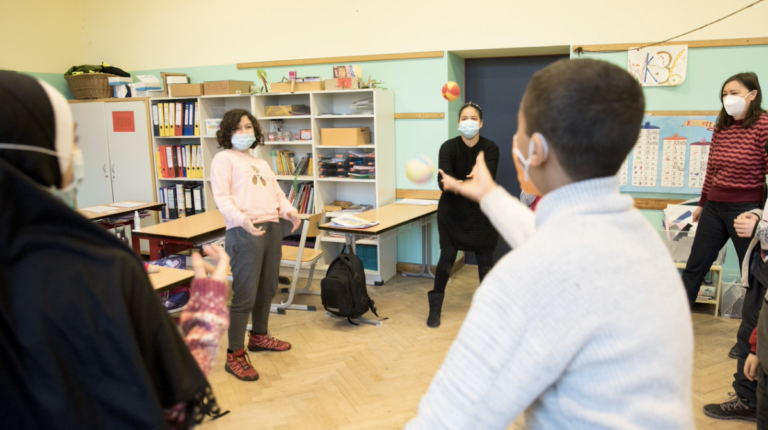Workshop 2 : Body at stake
Setting up: what do we need?
– A workspace: the room provided must be large enough to accommodate all the participants and allow freedom of movement, as the workshop requires physical commitment.
– A foam ball the size of a tennis ball
The participants
The methodology is aimed at nursery school pupils aged 4 to 7, with a maximum group size of 30 pupils.
Contributors
School teachers, educators, drama teachers.
Aims of this workshop
to develop pupils’ listening and observation skills
introduce them to group work
Time required
45 minutes
How it works
This workshop uses icebreaking techniques and an introduction to body expression.
Aim
At the end of the session, the children will have :
- learned to be more precise in their observations
- exercised their concentration
- experimented with an initial model of teamwork
1. Icebreaking
An icebreaking activity involves getting students to interact with each other in a comfortable, fun environment to create a pleasant working climate. Pupils are encouraged to make contact with peers they don’t usually talk or play with.
- The clap: in a circle, the children pass a clap to their neighbour (clap hands) as they go round the circle. For the clap to be passed, the pupils have to look each other in the eye before clapping their hands!
- First name ball: in a circle, the pupils pass the ball to each other, calling out the first name of the person they want to send it to first. Each child must receive the ball once, so that it goes around the whole class. You can then try to get them to reproduce the same throwing order to work on their memory. If a pupil is in any doubt, they can ask their classmates to help them remember who they threw the ball to.

2. Body at stake
Walking in space: the pupils are invited to walk in space. Ask them to walk alone, without following a classmate, and to always try to move towards an open space. Make sure they don’t all end up walking in a circle (which is almost always the case, even for adults!) Then they should listen to your instructions as they continue walking.
- Tempo: start by varying the tempo. Show them the example of the 5 speeds you are going to give. The normal walk, the turtle walk (in slow motion), the snail walk (the movement is barely perceptible), the cheetah walk (we walk very fast) and finally the spaceship walk (the fastest possible walk without running). Ask the students to be careful not to touch each other as they move! To avoid accidents. Then vary the sequence of steps, moving from the turtle to the spaceship, from the snail to the normal walk, and so on…
- on/stop/youpla: the pupils then have to try to respond as closely as possible to the instructions. When the leader says “Stop”, all the pupils have to stop at the same time. They only resume walking when the leader calls “Walk”. Similarly, when the students hear “Youpla”, they jump up and resume walking immediately. The teacher then follows the instructions as he/she sees fit for a few minutes until the pupils are comfortable with the exercise.
- The number: when the facilitator says a number, the pupils have to form small groups with as many people as the number announced. For example, the number 4 is announced, and the pupils have to get into groups of 4 as quickly as possible. You can also use small numbers if you have a large group. For example, if you want the students to form just two groups, you can announce “12” if your group is made up of 24 students. Similarly, you can announce the exact number of students present and see how long it takes them to realise that it takes the whole class to form this group.

- The conductor: a child leaves the classroom and a conductor is chosen. In a circle, the other children follow the conductor’s movements. The child who went outside returns and has to find out who the conductor is.
- The mirror game: in pairs, face to face, you have to follow your partner’s movements as if you were their exact reflection. One leads and then passes to the other. Be careful to ask them to keep their movements slow and simple! Ask them to be as precise as possible when acting out the reflection.
- In a circle, the facilitator calls out, one after the other, an animal, a means of locomotion, fairytale characters, etc. Each time, the pupils must turn around and mime what has been called out.
3. Closing ritual
Clapping
We suggest that you introduce a little ritual at the end of the session with the students. This brings the session to a pleasant close and creates a point of reference for the students.
We suggest a clapping, similar to the celebrations between sportspeople and supporters at the end of football matches. The facilitator leads this first clapping. In future sessions, the pupils will take it in turns to lead the clapping.
The leader stands facing the other members of the group so that everyone can see him or her. He or she stands with arms horizontal and claps his or her hands above his or her head. The others must follow suit, respecting their rhythm. Then, little by little, he/she will speed up until there is applause.
